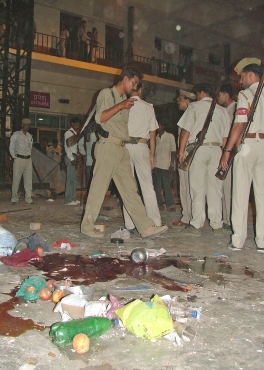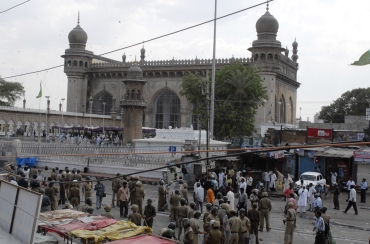
The blast that rocked the crowded Sheetla Ghat on the bank of Ganga in Varanasi on Tuesday evening claimed one life and injured scores of others. The blast took place while hundreds of people had gathered there for the routine Ganga aarti.
This is not the first time that a religious place has been targeted by terrorists. According to security experts, an attack on a religious site not only causes death and destruction, but also packs in the potential to trigger backlash and lead to communal clashes.
Let's rewind to those cases when terrorists chose places of worship for their dastardly attacks.
Text: Vicky Nanjappa

On September 25, 2002, the Akshardham temple at Gandhinagar, Gujarat, was attacked by two armed terrorists.
After gaining access to the temple, they opened fire and killed 29 people.
The terrorists were later killed by commandos of the National Security Guard.
In his recent confessions to the Federal Bureau of Investigation, LeT operative David Headley suggested that the Lashkar-e-Tayiba terrorists carried out the attack.

In 2006, blasts at two different sites shook Varanasi. The blasts took place at the Sankat Mochan Hanuman Temple and the Varanasi railway station, killing 20 people. Investigators said the terror strike was carried out by the HuJI (Bangladesh) and the blasts were triggered off by a timer device.
Although several arrests were made in connection with the blast, the three HuJI terrorists who carried out the strike managed to escape to Bangladesh.

On May 18, 2007, nine people were killed when a blast rocked the iconic Mecca Masjid in Hyderabad. In the subsequent police firing to control the mob, which was protesting the blast, five people were killed. The bomb was kept in a pipe and triggered by a cell phone.
The case has not been conclusively solved. The Hyderabad police initially claimed that the blast was carried out by HuJI terrorists. Later, the investigation was handed over to the Central Bureau of Investigation, which stated that the blast was carried out by some right-wing Hindu groups.

In 2006, a series of blasts struck the textile town of Malegaon in Maharashtra. The Malegaon blasts killed 37 people and injured scores of others. These high-intensity bombs had been placed on bicycles and triggered off later. Initially, investigators suspected that Pakistan-based outfits had planned the terror strike to incite communal passions and provoke clashes.
But the Anti-Terrorism Squad later claimed that right-wing leaders including Colonel Shrikant Prasad Purohit and Sadhvi Pragya Singh had planned and carried out the blast. The investigations concluded a year ago and a chargesheet has also been filed in the case.